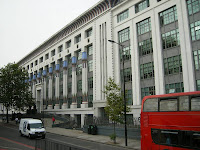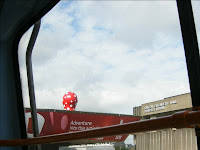Chalk Farm (Morrisons) to Turnham Green Church Monday August 24th 2009

A stuffy warm rather than overtly sunny day, and London brimming with tourists at a peak period. I was travelling alone so was limited as to how many sights I could take in. We left about 10.30, the driver optimistic the bus would complete what is quite a long trip. Morrisons is adjacent to a landscaped turning point for the buses, a re-cycling point and actually quite a siz eable modern housing estate all tucked between Camden Lock and the railway.
eable modern housing estate all tucked between Camden Lock and the railway.


A stuffy warm rather than overtly sunny day, and London brimming with tourists at a peak period. I was travelling alone so was limited as to how many sights I could take in. We left about 10.30, the driver optimistic the bus would complete what is quite a long trip. Morrisons is adjacent to a landscaped turning point for the buses, a re-cycling point and actually quite a siz
 eable modern housing estate all tucked between Camden Lock and the railway.
eable modern housing estate all tucked between Camden Lock and the railway.Going north and into town the buses take a 1-way system away from the main crowd of pedestrians and we passed both Camden Town tube and the end of the High Street complete with the statue to Richard Cobden. Camden have named a school after the 19th century reformer and politician though he did not really have any links with this part of London). Also h eading north the buses use the crescent rather than cruising alongside the very handsome Carreras Building. The bus was getting ever busier and just down Mornington Crescent I spotted a Blue Plaque but was not able to read it. The definitive plaque for Willie Rushton, who invented the game of Mornington Crescent, is in the station itself; web research tells me the plaque in the Crescent commemorates Walter Sickert (1860-1942), the painter and ‘Jack the Ripper’ suspect.
eading north the buses use the crescent rather than cruising alongside the very handsome Carreras Building. The bus was getting ever busier and just down Mornington Crescent I spotted a Blue Plaque but was not able to read it. The definitive plaque for Willie Rushton, who invented the game of Mornington Crescent, is in the station itself; web research tells me the plaque in the Crescent commemorates Walter Sickert (1860-1942), the painter and ‘Jack the Ripper’ suspect.
 eading north the buses use the crescent rather than cruising alongside the very handsome Carreras Building. The bus was getting ever busier and just down Mornington Crescent I spotted a Blue Plaque but was not able to read it. The definitive plaque for Willie Rushton, who invented the game of Mornington Crescent, is in the station itself; web research tells me the plaque in the Crescent commemorates Walter Sickert (1860-1942), the painter and ‘Jack the Ripper’ suspect.
eading north the buses use the crescent rather than cruising alongside the very handsome Carreras Building. The bus was getting ever busier and just down Mornington Crescent I spotted a Blue Plaque but was not able to read it. The definitive plaque for Willie Rushton, who invented the game of Mornington Crescent, is in the station itself; web research tells me the plaque in the Crescent commemorates Walter Sickert (1860-1942), the painter and ‘Jack the Ripper’ suspect.
We soon passed Regent’s Park Station, its exterior handsome enough to nearly live up to the nearby Nash Terraces and I spotted some chestnuts just about ready to fall. I studiously ignored the longest ever queues for Madame Tussauds, admiring instead the fabulous co-ordinated hanging baskets outside Portman Mansions, along here too is the University of Westminster, not quite as old as its name might imply. The Landmark (a hotel too posh to admit it is one) has taken over a gothic red-brick building complete with clock in the turret, and another Blue Plaque tantalizes me from Radnor Place.
For once we head down Praed Street at some speed and without delay, passing Paddington Station, though you wouldn’t know it if they did not announce the fact, its face to the world is so anonymous. Gloucester Terrace offers a contrast in housing with social blocks to the right and early Victorian villas to the left. As happened a couple of weeks ago we were held up by the mains replacement works in Queensway giving me time to admire a cyclist doing some excellent wheelies (on the pavement). An ambulance that had been waiting patiently like us suddenly lost it and started its siren and lights??
For once we head down Praed Street at some speed and without delay, passing Paddington Station, though you wouldn’t know it if they did not announce the fact, its face to the world is so anonymous. Gloucester Terrace offers a contrast in housing with social blocks to the right and early Victorian villas to the left. As happened a couple of weeks ago we were held up by the mains replacement works in Queensway giving me time to admire a cyclist doing some excellent wheelies (on the pavement). An ambulance that had been waiting patiently like us suddenly lost it and started its siren and lights??
Soon we were close to Notting Hill, already sporting signs leading up to next weekend’s Carnival, and not a few confused looking tourists. After a bit of a wiggle we were on Kensington Church Street, which was surely once a lane? As ever it has some very expensive a ntique shops and a mixture of fine old buildings, many in a vaguely Dutch gabled style, and some less nice fill-ins. The Churchill Arms’s floral display sure stands out, and I gather the drinks aren’t bad either. The bus here was much emptier, the locals presumably having no need of such lowly forms of transport.
ntique shops and a mixture of fine old buildings, many in a vaguely Dutch gabled style, and some less nice fill-ins. The Churchill Arms’s floral display sure stands out, and I gather the drinks aren’t bad either. The bus here was much emptier, the locals presumably having no need of such lowly forms of transport.
 ntique shops and a mixture of fine old buildings, many in a vaguely Dutch gabled style, and some less nice fill-ins. The Churchill Arms’s floral display sure stands out, and I gather the drinks aren’t bad either. The bus here was much emptier, the locals presumably having no need of such lowly forms of transport.
ntique shops and a mixture of fine old buildings, many in a vaguely Dutch gabled style, and some less nice fill-ins. The Churchill Arms’s floral display sure stands out, and I gather the drinks aren’t bad either. The bus here was much emptier, the locals presumably having no need of such lowly forms of transport.However, we were boarded by a young couple with a very smelly Staffie type dog whose owners loudly announced they really wanted the Number 28 and almost immediately leapt off to try and catch the one in front. Melbury Court had a Blue Plaque and this time I actually spott ed the name of Sir David Low, the political cartoonist (1891-1963). Olympia looks a bit sulky and run down in contrast to the row of dazzling modern buildings along this bit of the Hammersmith Road. A blink-and-you-miss-it plaque recalls Hammersmith’s role in the planning of D-Day. Then comes Hammersmith, which sadly is one giant one-way system seemingly now wrapping around the double storey bus garage, where we drove in and out, our time noted on a clipboard.
ed the name of Sir David Low, the political cartoonist (1891-1963). Olympia looks a bit sulky and run down in contrast to the row of dazzling modern buildings along this bit of the Hammersmith Road. A blink-and-you-miss-it plaque recalls Hammersmith’s role in the planning of D-Day. Then comes Hammersmith, which sadly is one giant one-way system seemingly now wrapping around the double storey bus garage, where we drove in and out, our time noted on a clipboard.
 ed the name of Sir David Low, the political cartoonist (1891-1963). Olympia looks a bit sulky and run down in contrast to the row of dazzling modern buildings along this bit of the Hammersmith Road. A blink-and-you-miss-it plaque recalls Hammersmith’s role in the planning of D-Day. Then comes Hammersmith, which sadly is one giant one-way system seemingly now wrapping around the double storey bus garage, where we drove in and out, our time noted on a clipboard.
ed the name of Sir David Low, the political cartoonist (1891-1963). Olympia looks a bit sulky and run down in contrast to the row of dazzling modern buildings along this bit of the Hammersmith Road. A blink-and-you-miss-it plaque recalls Hammersmith’s role in the planning of D-Day. Then comes Hammersmith, which sadly is one giant one-way system seemingly now wrapping around the double storey bus garage, where we drove in and out, our time noted on a clipboard.We then continued down King Street, a once vibrant shopping street that shows signs of suffering after Westfield opened and was now offering cut price and bargain items from its shops. Further along King Street was a beautifully preserved pub – the Salvation Pub, run of course by the local brewery Fullers. A move upmarket was announced by passing Latymer Upper school – very red brick and public (i.e. private) and onto leafy Chiswick, with signs down to Chiswick House, – so leafy in fact the trees kept banging the bus and making me jump! We passed another attractive hostelry ‘The Packhorse & Talbot’ then Chiswick Common and the bus station, where we changed drivers, as he had indicated to me at Chalk Farm.
Very soon thereafter we slipped to the left for Turnham Green, which unlike many of the other head-stops (which are green in name only) is actually quite a sizeable open space with a large and handsome Giles Gilbert Scott church at its centre. The journey had taken pretty much the hour and 18 minutes indicated at the outset.





























